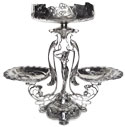
Art Nouveau
Art Nouveau climaxed in the years 1892 to 1902. A high point in the evolution of Art Nouveau was the Exposition Universelle of 1900 in Paris, in which the 'modern style' triumphed in every medium. It probably reached its apogee, however, at the Esposizione Internazionale d'Arte Decorativa Moderna of 1902 in Turin, Italy, where designers exhibited from almost every European country where Art Nouveau flourished.Dynamic, undulating, and flowing, with curved 'whiplash' lines of syncopated rhythm, characterised much of Art Nouveau. Another feature is the use of hyperbolas and parabolas. Conventional mouldings seem to spring to life and 'grow' into plant-derived forms.
As an art movement it has affinities with the Pre-Raphaelites and the Symbolism movement, and artists like Aubrey Beardsley, Alphonse Mucha, Edward Burne-Jones, Gustav Klimt, and Jan Toorop could be classed in more than one of these styles. Unlike Symbolist painting, however, Art Nouveau has a distinctive visual look; and unlike the backward-looking Arts and Crafts Movement, Art Nouveau artists quickly used new materials, machined surfaces, and abstraction in the service of pure design.
Japanese wood-block prints, with their curved lines, patterned surfaces, contrasting voids, and flatness of visual plane, also inspired Art Nouveau. Some line and curve patterns became graphic clichés that were later found in works of artists from all parts of the world.
Art Nouveau did not negate the machine as the Arts and Crafts Movement did, but used it to its advantage. For sculpture, the principal materials employed were glass and wrought iron, leading to sculptural qualities even in architecture.
Art Nouveau is considered a 'total' style, meaning that it encompasses a hierarchy of scales in design — architecture; interior design; decorative arts including jewelry, furniture, textiles, household silver and other utensils, and lighting; and the range of visual arts.
Moreover we produce Liberty artifacts of Orivit style, which in 1900 was awarded the gold medal at the World Exhibition of Paris. Orivit was the name by which the alloy of tin and silver was called. This kind of metal was brighter than the traditional pewter and it became a real trademark of Germany company founded by Ferdinand Schmitz Hobert.
Kayserzinn is the name of another milestone of Liberty style, which corresponds to pewter manufactures made by the German company “JP Kayser & Sohn Ag”. Big designers like Hugo Leven and Hermann Fauser gave great prestige to the brand by their inimitable creations.
Finally we have chosen to follow in the footsteps of Archibald Knox, who was an Irish artist and designer with an extraordinary passion for modern style and special Scottish ancestry. In fact the Celtic Art influenced his creations arousing a mix of styles that made them unique and indispensable for Art Nouveau lovers. Knox became famous thanks to the projects made for Liberty & co. of London. He established himself as a flagship of the company.
(Art Nouveau)
HOME & INTERIORS
KITCHEN & DINING



















































































































